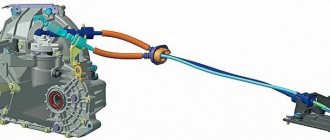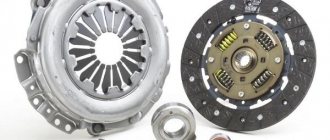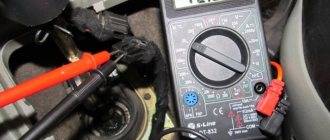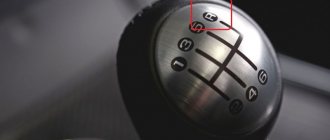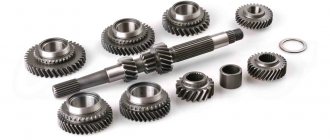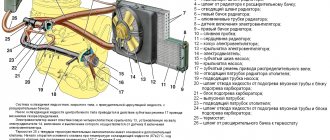The question just came up when I drove the car. I started it, warmed it up a little (a little less than 50), and drove out of the parking lot in reverse. I started driving, but when going into 2nd it was a little slow to turn on. I'm stretching in a traffic jam: 1st and 2nd are a bit stiff when moving (as if with a slight crunch), 3rd and 4th are all good.
I tried to turn it on on the spot, everything is fine, as before! but when moving almost every time it is tight, but not always.
Car: 2114, oil changed 2 thousand. back (ZIC 80W-90). Tell me who has encountered this.
Checkpoint disassembled
The best way to prevent breakdowns is to take preventive measures. Unfortunately, even the most careful care is not able to protect the box from the occurrence of certain malfunctions.
Types of checkpoints
Today, all cars are equipped with one of three types of gearboxes.
- Mechanical. Speed shifting is done manually using a special lever.
- Automatic. No external influence is required to change gears. Switching is carried out depending on the degree of pressure on the brake and gas pedals. In this case, reverse gear is engaged manually.
- CVTs. This is a mixed type of gearbox, where the bulk of the work is performed automatically, but if necessary, the gearbox is switched to manual mode.
Box nuances
The VAZ 2114 uses a five-speed manual gearbox. It is quite simple in design, which allows you to independently carry out preventive and repair work.
Device diagram
Experts recommend identifying a malfunction at the initial stage of its occurrence, since delaying means wasting even more time, effort and money.
Typical breakdowns
General form
Based on some signs, it can be determined that certain gearbox components on a VAZ 2114 need to be repaired.
- When a certain gear is engaged, it does not lock properly and crashes. This indicates that the fastenings of the gear teeth and clutch are worn out. When reverse gear is difficult to engage on a VAZ 2114, you will have to take certain measures. Repair consists of replacing the damaged element. If the gear engages spontaneously, the reason may also lie in wear, delamination and cracking on the rubber element of the rear support. Just replace it.
- To engage the gear you have to apply more force than usual. If the reverse gear on a VAZ 2114 car does not engage, the problem is most likely hidden in loose or worn teeth attaching to the hinge. This may also occur due to deformation of the torque rod or the appearance of cracks in the plastic part of the gearbox drive.
- There is noise in neutral gear. The oil level may be too low or its original viscosity may have been lost. Plus, a similar symptom is characteristic of wear on the upper bearing of the input shaft. Check this element, inspect the oil level and quality.
- It is not uncommon for reverse gear to engage with a crunch on a VAZ 2114. The problem here is the wear of the synchronizer. If the problem is not corrected at the first sign of its occurrence, this may result in the need to replace the entire gear assembly and synchronizer.
- Noise is generated while the car is moving in certain gears. A similar malfunction occurs due to a damaged lower or upper bearing. Along with the noise, the lever may jam. The only option is to carry out a full diagnosis of the gearbox.
- A knocking noise occurs in a certain gear with or without load. The problem lies in the drive gear, which will have to be replaced.
- When the transmission is engaged, a cracking sound is heard. This indicates wear of the synchronizer blocking ring or the need to replace the satellite axle. The box will have to be sorted out to fix the damage.
- Oil leaks from the box. The reasons can be very diverse, so you will have to carefully diagnose the checkpoint.
Advice for motorists
Above we have already talked about why the reverse gear on the VAZ 2114 does not engage and how to correct this situation. But it should also be noted that proper and timely care of the gearbox will help either completely avoid such a situation or postpone it for as long as possible.
There are only two basic rules for this care:
- Change gears, as well as accelerate and brake the vehicle as smoothly as possible, without jerking.
- Periodically check the oil level, replenish it as it is used, and also replace the entire volume if it is worn out.
These simple rules will help to significantly increase the service life of the entire box and its individual parts.
New or refurbished old?
Disassembled gearbox
As practice shows, such gearboxes are approximately 30-70% cheaper than purchasing a new gearbox.
There is only one important condition for successful savings on such significant repairs. It must be a reliable, proven company. Such companies value their own reputation, so they do not deal with fakes or low-quality repairs. In order to receive positive customer feedback and attract new customers, they simply must do everything well, conscientiously. That’s why today there are fly-by-night companies and companies where, over the years of work, they have established themselves as a reliable and responsible specialist in repairing and replacing gearboxes. You yourself understand perfectly well who you need to contact if you have problems with your box.
For what reasons do interruptions occur?
The gearbox is not only one of the most complex, but also one of the most basic components in any vehicle. The reasons for malfunctions that make it difficult to engage first gear can be associated with both incorrect use of the unit and driving on a bad road surface. In any case, if you don’t know why the speed turns on poorly, then this indicates a certain breakdown of the unit itself.
Gear lever
It should be noted that a similar problem often occurs in older cars that are bought second-hand and not at car dealerships. Therefore, if you purchased a used car, then you shouldn’t even be surprised by such a problem, especially since similar faults will appear in any car sooner or later. In addition, if you try to turn on the speed and this happens, but very poorly and with great difficulty, then over time the unit selector may completely stop responding to any commands from the motorist. Naturally, not every driver will be able to constantly start driving in second gear, so it is important to understand the reasons why first gear is difficult to engage.
Below is a list of breakdowns that can cause the gear lever to shift gears poorly:
- The problem is in the clutch operation - the mechanism engages poorly, disengagement is incomplete. This problem often occurs in domestically produced cars and in most cases it is due to the fact that the mechanical clutch cable comes off from the mounting point. In fact, it is not particularly difficult to identify this - if the cable breaks, the pedal will be recessed into the floor and will not move. This, as you understand, is directly related to the operation of the clutch, and not the gearbox.
- There was a breakdown in the operation of the drive rod for controlling the gear shift mechanism. Then not only the first, but also the reverse and other speeds will turn on poorly.
- Failure of the unit's jet thrust.
- For unknown reasons, the fastening bolts located on the side or selector rod for selecting the gearbox mode have become loose. The problem is solved by tightening the bolts.
- The transmission gear shift drive was incorrectly adjusted.
- The plastic elements in the gearbox control drive have failed or have expired.
- The link was poorly adjusted. As you know, the purpose of the rocker is very important in connecting the gearbox and the gear selector, so incorrect adjustment may well be the cause of the problem. In addition, the plastic bushings on this link could wear out or fail.
- Failure of synchronizers can also be called one of the most common failures in a gearbox. Unit synchronizers are brass bushings necessary for easier switching of unit modes. Since brass itself is a soft material, it can wear out and wear out during the operation of the vehicle. To correctly diagnose the condition of the synchronizers, you should pay attention to the operation of the gearbox - if a grinding or unpleasant sound appears when shifting gears, then the problem is in them. Moreover, this sound will appear constantly when you try to engage first gear. If only sound appears, but the gearbox selector switches to one mode or another without problems, then a malfunction will occur soon.
- Failure of gearbox bearings. Such a malfunction does not occur so often, one might even say that it is rare, but any motorist can still encounter it. If you own a car with a manual transmission, then the bearings could get stuck in it, as a result of which the shaft stops rotating along the path. In such cases, it is difficult to engage first gear; at other speeds the problem usually does not appear.
- The box shaft has failed. The unit shaft is usually not subject to operational wear or very heavy loads, but the malfunction may be caused by a factory defect. In the event that even minor mistakes were made in production, the shaft may well break. If so, then the problem of engaging the first gear may be just the beginning of a major breakdown that you will face. As practice shows, often in such cases the unit itself breaks down completely.
- The problem of clutch failure is relevant for owners of cars with automatic transmission. There are cases when, if the clutches are not functioning correctly, a push occurs when the first speed is turned on, but then everything works fine. The problem can only be solved by replacing the clutches.
Failed bearing
You, as a motorist, need to understand that failure of the unit shaft or bearings cannot be diagnosed at home. Only experience and equipment will help you understand this reason. Accordingly, if problems arise with turning on the first speed, it is advisable to immediately contact a professional.
Extending the service life of gearboxes
Transmission shaft assemblies
There are only two recommendations.
- Always try to monitor the oil level in the gearbox. If it drops, be sure to top it up immediately, do not delay the procedure until later. When the oil becomes unusable, change it completely, rather than fill in the missing amount.
- Avoid aggressive use, do not jerk the gears sharply, accelerate smoothly, and brake similarly. A simple caring attitude towards the gearbox will allow you to avoid wear and tear and numerous breakdowns.
As you can see, solving problems with checkpoints is not so easy. Therefore, the best option is to prevent their occurrence.
As you already understand, we will talk specifically about a manual “box” and about shifting gears (or rather, not shifting) on it. I have quite a lot of experience in this area; I personally repaired cars such as VAZ 2114, VAZ 2110 (and the 10th family in general). To say that there are global differences between foreign cars, there really aren’t any! So if your speed is not cut off, then the reasons may be similar. In general, the article will be useful, at the end, as usual, there is a video...
THE CONTENT OF THE ARTICLE
A fairly large number of such questions come to me, especially from novice drivers of our VAZs! Especially with front-wheel drive, because in rear-wheel drive cars the lever was installed in the manual transmission itself. I want to answer everyone right away - the problem of non-inclusion may not always be cardinal! Often it’s a small matter, something just got loose or unscrewed from time to time, as a rule, this happens in 50% of cases.
Therefore, I will try to break the material into two large components - simple and complex faults.
For those with automatic
If your car has an automatic transmission. It will not hurt you to know the modes in which your machine can operate:
- P – For parking and starting the engine. Switching to this mode is possible only after the machine has completely stopped.
- R – To move backwards. Switching to this mode is also possible only after stopping the car and with the brake pedal pressed.
- N – Neutral. When the engine is completely disconnected from the gearbox.
- D – Moving forward without restrictions on gear shifting (the most commonly used operating mode of the automatic transmission).
- D3(S) – Low gears for climbing and braking engines on descents.
- D2 – Mode for difficult conditions (slippery or mountainous roads). Gears above second are not shifted, that is, only first and second gears are engaged.
- D1(L) - Movement occurs only in 1st gear, used off-road on mud, snow or ice, where you need to drive without changing the throttle, and also to overcome steep climbs.
The automatic transmission also has a button on the mode shift lever with the inscription O/D OFF. When it is turned on, the inclusion is prohibited, increasing the gears of the analogue of the 5th gear of the manual transmission. That is, if your automatic machine has 4 gears for moving forward, then for more dynamic acceleration it will use only three lower gears.
About a faulty automatic transmission, an automatic transmission is much more complex than those encountered with a manual transmission, and the chances of repairing it in your garage are slim. But despite this, you still need to know something about it, if only in order not to harm it through improper use.
An automatic transmission is much more demanding in terms of accuracy in maintaining the oil level in it than a manual transmission. Both too low and too high oil levels are very harmful to her. Both of these can lead to serious damage. In both cases, oil foaming occurs. When there is a lack of oil due to the fact that the oil pump begins to capture air along with the oil. When there is excess oil, it foams on the rotating parts, which in this case are immersed in it. Foamed oil compresses better and has low thermal conductivity. Therefore, if you operate a machine with such oil, the pressure in its control systems will be low. Which will lead to slipping of the clutches and their intensive wear. Deteriorated thermal conductivity will not allow all excess heat to be removed. Which, together with low pressure, will lead to the machine failing and requiring serious repairs.
Foamed oil has more volume. Therefore, checking the oil will show the level is too high. If you find that the oil level has risen for no apparent reason, you need to turn off the engine and let the oil settle. After this, check the level again. If it turns out to be low, you need to safely add the required amount and repeat the test.
The oil level in the machine is checked using a dipstick or through a control hole closed with a plug.
How to check the oil level using a dipstick
- Warm up the oil to operating temperature (to do this you need to drive about 15 km).
Select a flat horizontal area for measurement. Put the car on the handbrake.
- Move the lever to select the operating mode of the box through all positions, holding in each position for 3 to 5 seconds, until the machine operates.
- Leave the mode selector in position P, and in this position determine the oil level.
- Without turning off the engine, remove the oil dipstick, wipe it dry and reinsert it into the tube until it stops, then pull it out and read the readings. The upper limit of oil traces on a dry dipstick should be at the mark with the inscription “hot” or in an area with intersecting notches.
If the level is insufficient, you can add oil through the tube into which the dipstick is inserted. Do not forget that the automatic transmission is afraid of dirt, so add only clean new oil. Wipe the dipstick with a clean cloth from which the threads do not fall out.
When checking the oil level, pay attention to its appearance. Dark liquid with a burning smell indicates that not everything is in order in the unit. First, try changing the oil and filter in the automatic transmission. The milky color of ATF indicates that coolant has entered the box. The coolant softens and swells the material from which the clutches are made. Do not hesitate to change such oil, having first eliminated the cause of antifreeze getting into the box, otherwise significant damage will be caused to the machine. Coolant may enter the box due to a leak in the oil section in the radiator of the cooling system. In this case, the emulsion will be observed both in the box and in the engine cooling system.
The most common machine malfunctions
- The car does not move forward or reverse normally. Possible reasons: wear of the forward clutch clutches, a defect in the piston of this clutch, breakage of the rings of the same clutch, jamming of the valve body valves.
- There is no reverse speed, forward there are only 1 and 2. Probable causes: wear of the reverse clutch clutches, a malfunction of the piston of this clutch, damage to the spline joint in the drum body, another defect of this drum.
- There is no rear, everything works forward. Reasons: wear of the brake band, malfunction of the piston of this band or breakage of its rod, defects in the braking package.
- There is no movement either forward or backward when you turn on any mode, there is a shift push, but the car stands still. Causes: torque converter malfunction, lack of oil, clogged filter.
- Only reverse, 1st and 2nd gears are engaged. Reasons: valve jamming in the valve body, low oil level, general wear of pistons and clutch clutches that do not engage.
Gearbox linkages and rods
I remember I was “infuriated” on the VAZ 2114 by the fact that the gearbox lever was swinging from side to side like a “spoon in a glass”; I always wanted to make it stiffer, in some way. But there was only one way, to climb down the car and play with the scenes and rods. In principle, they can be released, tightened, the lever can be adjusted for tilt, etc. In general, I played around, but I noticed that if I press the lever too hard to the left, the ability to engage gear (first and reverse) disappears. This manifests itself when the car is not running, I’m already silent about the running engine.
Often the slides break, or they fly out of the fastenings, or the wear is simply enormous and they need to be replaced (this happens with high mileage). The very first thing we do is climb under the car and look at them.
Video “What to do if gears are difficult to engage”
Recommendations on what to do if it is impossible to engage first gear were given by a Ukrainian driving instructor.
The question just came up when I drove the car. I started it, warmed it up a little (a little less than 50), and drove out of the parking lot in reverse. I started driving, but when going into 2nd it was a little slow to turn on. I'm stretching in a traffic jam: 1st and 2nd are a bit stiff when moving (as if with a slight crunch), 3rd and 4th are all good.
I tried to turn it on on the spot, everything is fine, as before! but when moving almost every time it is tight, but not always.
Car: 2114, oil changed 2 thousand. back (ZIC 80W-90). Tell me who has encountered this.
When gears shift poorly, driving a car becomes not only unpleasant, but also unsafe. Let's look at the main reasons why gears shift poorly or don't shift at all. And since the automatic transmission and manual transmission are too different, we will consider them separately.
Drive and clutch cables
For rear-wheel drive models (VAZ 2101 - 2107), the gears are engaged hydraulically. That is, when you press the clutch, the fluid pushes the piston, which in turn pushes the clutch fork, which retracts the disc. For front-wheel drive models (VAZ 2108 - 2115), there is no hydraulic connection; everything is done here by mechanics, or rather by the clutch cable, which is connected to the pedals. If your slave cylinder leaks on a rear-wheel drive car or the cable breaks on a front-wheel drive car, the car will not engage in gear. The “fork” simply won’t work. We just check and replace damaged parts.
Synchronizers
If, when the engine is running, you do not engage gears, or shifts occur with VERY great effort and CRUNCHING! Then there may be a problem with the manual transmission synchronizers. Without going too deep, these are soft gears (usually brass or copper) that synchronize the shafts for soft and fast shifting. If they wear out, then shifting may disappear altogether! In general, we are definitely changing.
Engine mounts
I personally have never had this happen, but many people write that this is a fairly common problem. Actually, the problem is this: the engine hangs on cushions, the gearbox is connected to it (manual transmissions, by the way, have their own cushions). It happens that the fastening breaks, or it unscrews. The engine or “box” may sag, the scenes may break, or they will hit something.
THEN there is another not very serious problem - these are pillows! If the programs don’t turn on, then we watch them.
These malfunctions, AS I THINK, ARE NOT PROBLEMS AT ALL! Anyone can identify them on pits or lifts, and this is done quite quickly. Personally, I came across rockers and cables, using the example of a VAZ, a clutch cable.
However, if you have checked everything, and the gears do not engage with the engine running. Then it’s worth looking at the box itself and the accompanying attachments. Let's move on to complex faults.
Reverse gear, first and other speeds do not engage when hot
Owners of cars with a manual transmission often encounter the problem of poor gear engagement, which occurs after starting and warming up the engine, that is, “on hot”. In this case, engaging one or more gears may not only be difficult, but also be accompanied by extraneous noise or unnecessary vibrations.
In this case, the gearbox shifts normally when the engine is turned off. Next, we will look at the common reasons why this malfunction occurs, as well as what to do if the gears are difficult to engage when heating.
Clutch disc and flywheel
In fact, wear occurs both at the clutch disc and at the flywheel itself. However, here, most likely, the gears will shift, but slip! You release the clutch pedal, but slippage occurs, that is, the car does not move, and it may jerk.
We look at the disk, maybe change it. We also look at the wear on the flywheel! If it is large, then we change it completely.
From experience I can say that our working VAZ 2111 was used mainly intercity, after 2 - 3 years the mileage was very high. The following symptoms began to appear: the gears turned on very poorly when the engine was running! We removed the manual transmission, looked at the basket - clutch disc - flywheel. And everything went for replacement, there was a lot of wear, and one petal on the basket was cracked. They even changed the release lever and the fork.
If the reason is not eliminated even now, then the problem is in the gearbox itself! It's worth taking it apart and looking at it
Repair and replacement
It is quite difficult for novice motorists to even simply determine why their gearbox is not working. What can we say about replacing the gearbox seal on a VAZ 2114, which requires a certain skill and knowledge in the field of car repair.
Unfortunately, if you ignore the initial signs of a gearbox malfunction, this may result in a full-fledged need to replace the entire unit. Many are even afraid to ask the current cost of a new gearbox for the “fourteenth” model. But we will say. Today such a unit will cost you at least 15 thousand rubles. Moreover, this price does not include installation services. Changing an entire gearbox yourself is not an easy task.
Another big disadvantage of replacing it yourself is the lack of a warranty. The factory will only provide it to you if the replacement is performed by a certified service station. So we strongly recommend that you contact an official dealer if it comes down to replacing the box.
Let's be frank. Situations in which a car is rendered unsuitable for transmission repair are very rare. Most often, something like replacing the gear selector rod seal on a VAZ 2114, gears, levers and other components is required.
It is difficult to carry out diagnostics on your own in a garage environment. To correctly identify a breakdown, you will need at least a lift and a driver’s extensive experience in car repair. But it is best to carry out diagnostics at a car service center with the appropriate equipment. Whether you entrust them with the repairs or handle this stage yourself is up to you.
The cost of repairing a gearbox on a VAZ 2114 is influenced by several factors:
- Location;
- Skill level of the craftsmen;
- Clauses of the concluded contract for the replacement or repair of the gearbox;
- Level of car service (regular garage-type service station or full-fledged car service with a large staff and new equipment).
Manual transmission bearings
And the last thing that could be the bearings - although they are very strong in the box, sometimes they also “stick”. The box will work like a tractor, especially when warm.
In any case, if you have problems in the gearbox itself, then this is an expensive repair. It is also better to entrust it to professionals, because the gearbox is a very complex mechanism.
As you can see, there are quite a few reasons, but in fairness it is worth noting that mechanical transmissions are a fairly reliable unit; they themselves break down quite rarely, especially if you change the transmission fluid on time and pour a branded one of very good quality.
If the gears do not engage, then these are most likely “attached” problems, starting from the rockers and cables, ending with the basket, clutch disc and flywheel.
Now let’s take a look at a short video version of my article.
And that's ALL for me! I think the information will definitely be useful, read our AUTOBLOG.
( 10 votes, average: 4.70 out of 5)
Causes
The reasons why reverse gear engagement is poor or difficult may be as follows:
- loosening of the fastening clamp of the rocker, due to which the length of the rod is not enough to fully engage the gear;
- jamming of the reverse speed lock;
- spring breakage and debris getting into the guide grooves of the gear selection mechanism;
- spontaneous loosening of the selection mechanism mounting bolts;
- the clamp bolt is cut off;
- wear of the clutch disc and release bearing;
- incorrect adjustment of the clutch and clutch pedal;
- low oil level in the box or the need to replace it.
